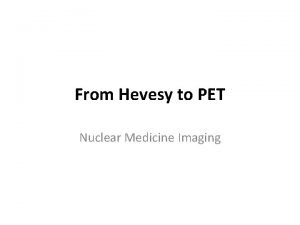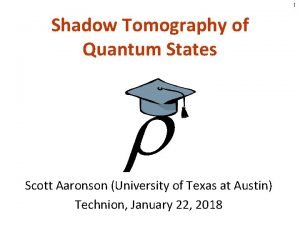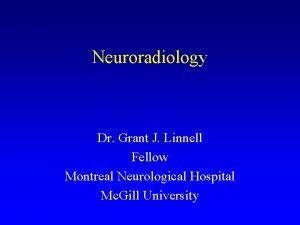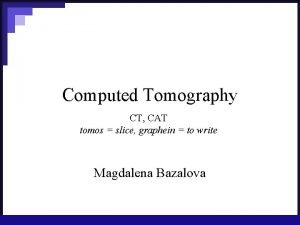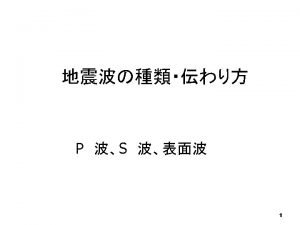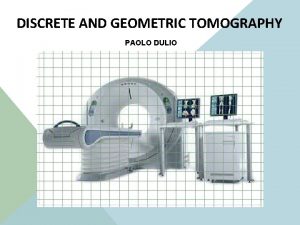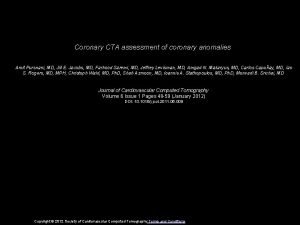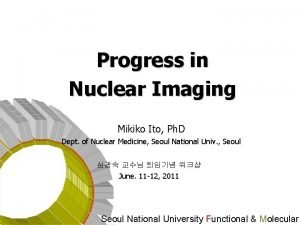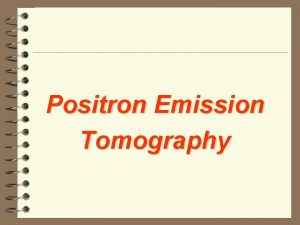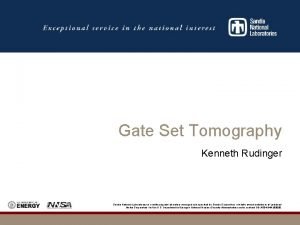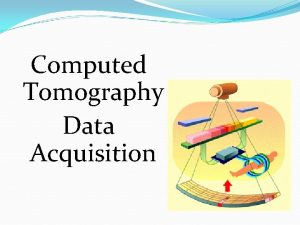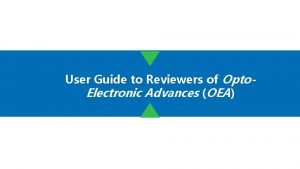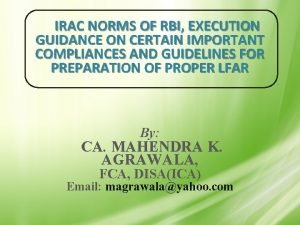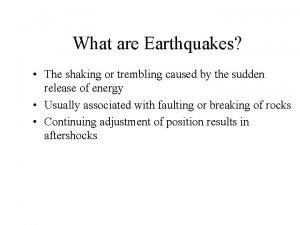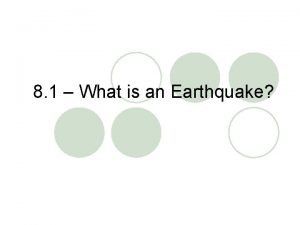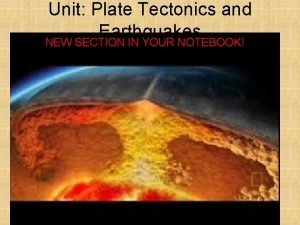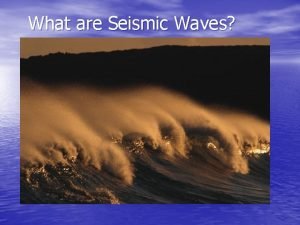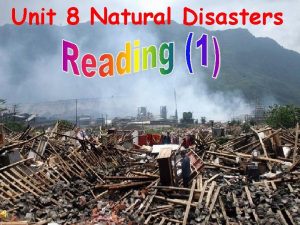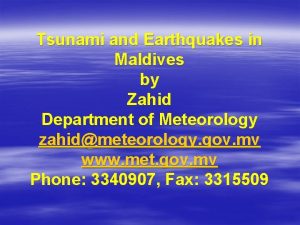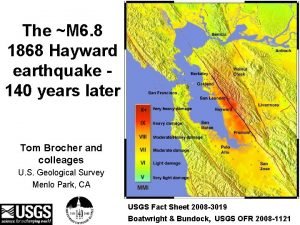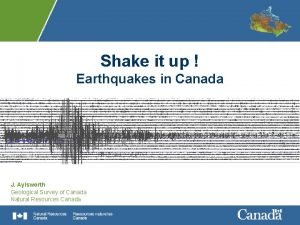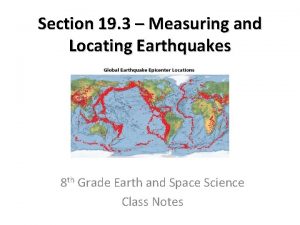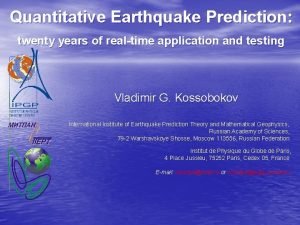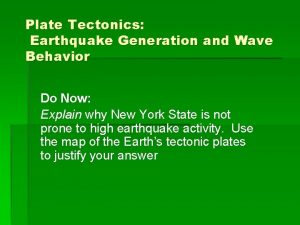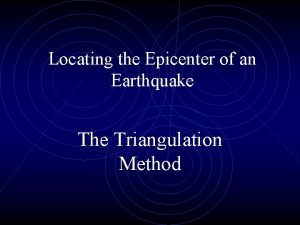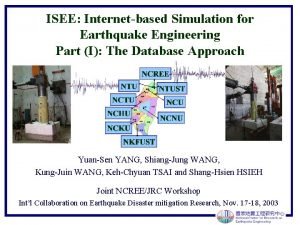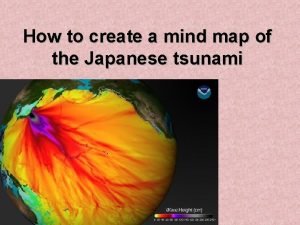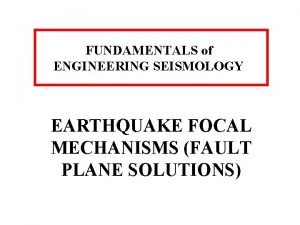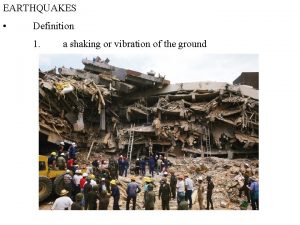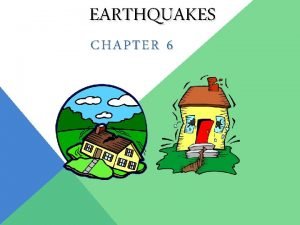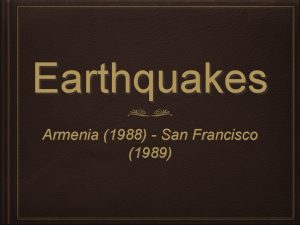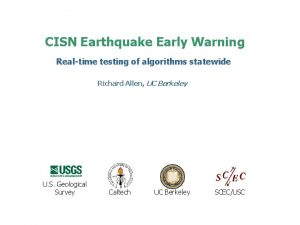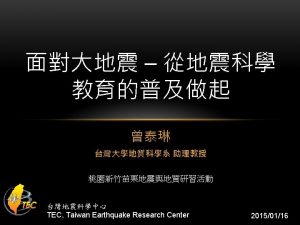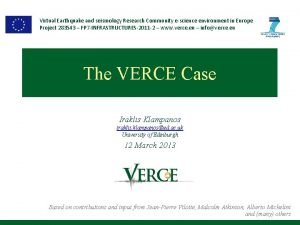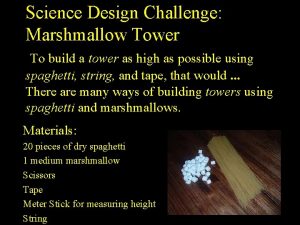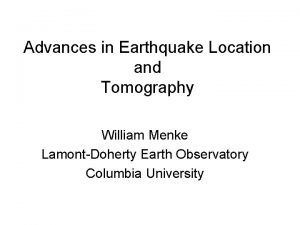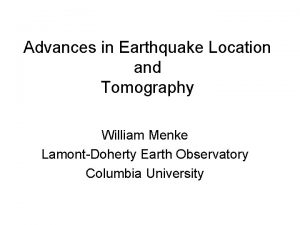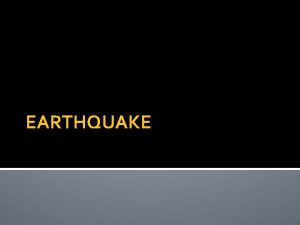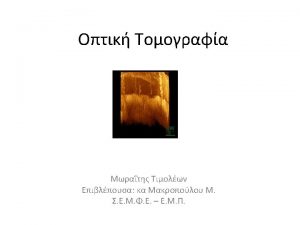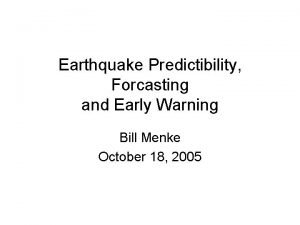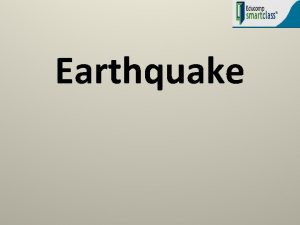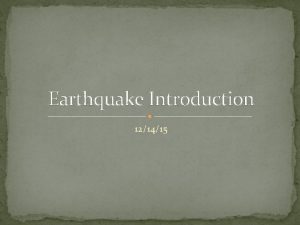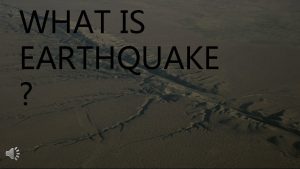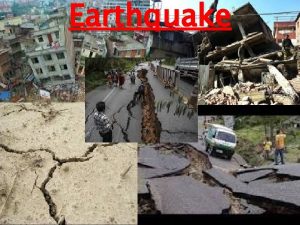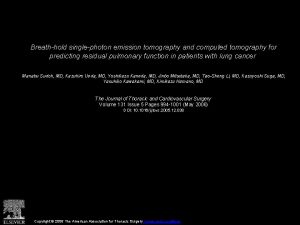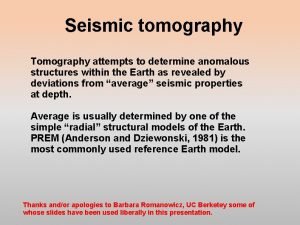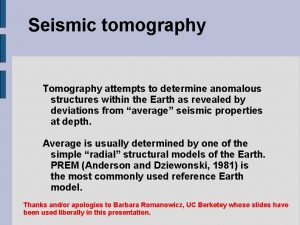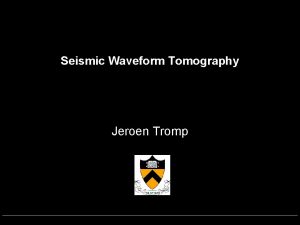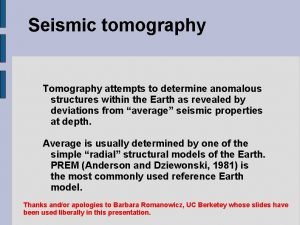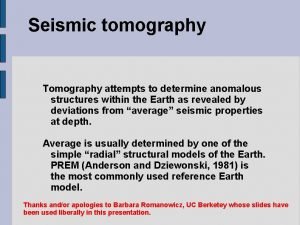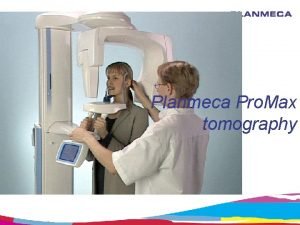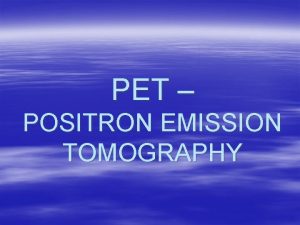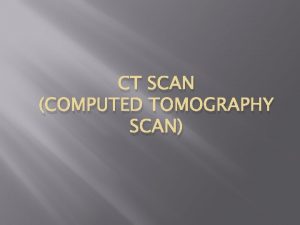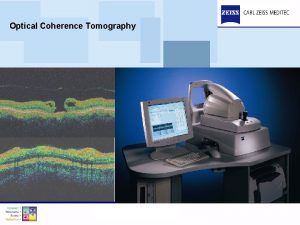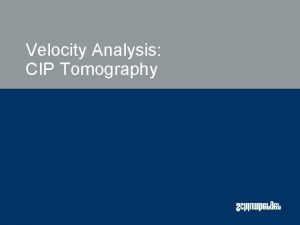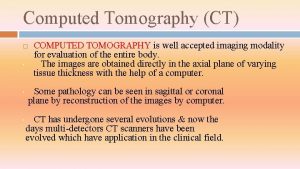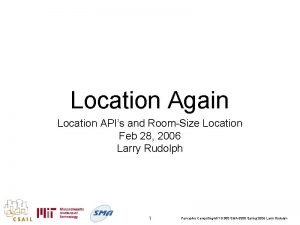Advances in Earthquake Location and Tomography William Menke





























































- Slides: 61

Advances in Earthquake Location and Tomography William Menke Lamont-Doherty Earth Observatory Columbia University

Outline Part 1: Advantage of using differential arrival times to locate earthquakes Part 2: Simultaneous earthquake location and tomography Part 3: In depth analysis of the special case of unknown origin time

Part 1 Advantage of using differential arrival times to locate earthquakes


that was the recent Gulf of Mexico earthquake, by the way …

Locating an earthquake requires knowing the seismic velocity structure accurately




What’s the best way to represent 3 dimensional structure Best for what? compatibility with data sources ease of visualization and editing facilitating calculation

Overall organization into interfaces Small-scale organization into tetrahedra Linear interpolation within tetrahedra implying rays that are circular arcs

seismometer earthquake

Location Errors: = 0. 5 degree = 55 km = 30 miles Note: this preliminary calculation used data from a limited number of stations

Two parallel approaches work to improve earth model design earthquake location techniques that are as insensitive to model as possible

Waves from earthquake first arrived in Palisades NY at 15: 00: 32 on Sept 10, 2006


Arrival Time ≠Travel Time Q: a car arrived in town after traveling for an half an hour at sixty miles an hour. Where did it start? A. Thirty miles away Q: a car arrived in town at half past one, traveling at sixty miles an hour. Where did it start? A. Are you crazy?

Suppose you contour arrival time on surface of earth Earthquake’s (x, y) is center of bullseye but what about its depth?

Deep Shallow Earthquake’s depth related to curvature of arrival time at origin



Earthquakes in Long Valley Caldera, California located with absolute traveltimes Courtesty of Felix Walhhauser, LDEO

Earthquakes in Long Valley Caldera, California located with differential traveltimes Courtesty of Felix Walhhauser, LDEO

differential arrival time = difference in arrival times

mean origin time cancels out T = arrival time TT = travel time To = Origin Time (start time of earthquake)

Station i


Very accurate DT’s !

A technical question for Applied Math types … Are differential arrival times as calculated by cross-correlation less correlated than implied by the formula They seem to be. If so, the this is another advantage of using the method


How does differential arrival time vary spatially? Depends strongly on this angle

In a 3 dimensional homogeneous box … maximum minimum mean If you can identify the line AB, then you can locate earthquakes

as long as you have more than two earthquakes

In a vertically-stratified earth, rays are bent back up to the surface, so both Points A and B are on the surface. y ra t ron vef wa The pattern of differnetial traveltime is more complicated …

The same idea works … p q

Patterns of differential arrival time B A B B C C C A B A A C Can you guess the orientation of the two sources in these six cases?

This pattern an be seen in actual data, in this case from a pair of earthquakes on the San Andreas Fault A B C Boxes: differential arrival times observed at particular stations Shading: theoretical calculation for bestfitting locations of the earthquake pair

Another example …

What is the practical advantage of using differential arrival times to locate earthquakes My approach is to examine the statistics of location errors using numerical simulations Compare the result of using absolute arrival time data And differential arrival time data When the data are noise Or the earth structure is poorly known

Geometry of the numerical experiment …

Effect of noisy data (10 milliseconds of measurement error) differential data absolute data

Effect of near surface heterogeneities (1 km/s of velocity variation with a scale length of 5 km) differential data absolute data

Both absolute locations and relative locations of earthquakes are improved by using differential arrival time data when arrival times are nosily measured and when near-surface earth structure is poorly modeled Relative location errors can be just a few meters even when errors are “realistically large”

Part 2 Simultaneous earthquake location and tomography




simultaneous earthquake location and tomography? Many earthquakes with unknown X, Y, Z, To Unknown velocity structure Solve for everything Using either absolute arrival times or differential arrival times

A numerical test 11 stations 50 earthquakes on fault zone Heterogeneity near fault zone only

True earthquake locations And fault zone heterogenity ( 1 km/s) Reconstructed earthquake locations And fault zone heterogenity, using noise free differential data Note the amplitude of the “signal” is only 1 ms, so noise might be a problem.

Reality Check: How big is the Signal? How much better are the data fit? When the earth structure is allowed to vary compared with holding a simple, layered earth structure fixed? Answer: 0. 7 milliseconds, for a dataset that has traveltimes of a few seconds Need very precise measurements!

Part 3 Is Joint Tomography/Earthquake Location Really Possible ? Study a simplified version of the problem In depth analysis of the special case of unknown origin time but known location



Station 1 2 3 4 Event 2 Event 1 Event 3

If you can … Then that structure is indistinguishable from a perturbation in origin time!

Case of sources near bottom of the model This velocity perturbation causes constant travel time perturbation for a station on the surface anywhere in the grey box for the event at but zero traveltime perturbation for all the sources at !

Case of sources near top of model This velocity perturbation causes constant travel time perturbation for a station on the surface anywhere in the grey box for the event at but zero traveltime perturbation for all the sources at !

But you can always find such structures! And they often look ‘geologically interesting’ Yet their presence of absence in an area cannot be proved or disproved by the tomography.

Summary Part 1: Earthquake location with differential data is the way to go! Part 2: Simultaneous tomography / earthquake location possible with differential data, but requires high-precision data. Part 3: Coupled Tomography/Location is extremely nonunique and extremely likely to fool you.

 Computed tomography
Computed tomography Chodorma
Chodorma Shadow tomography of quantum states
Shadow tomography of quantum states Seismic tomography ______.
Seismic tomography ______. Radiology timisoara
Radiology timisoara Positron emission tomography
Positron emission tomography Positron emission tomography
Positron emission tomography Hematome
Hematome Ring artefact
Ring artefact Seismic tomography
Seismic tomography Tomography
Tomography Amit pursnani
Amit pursnani Positron emission tomography
Positron emission tomography Positron emission tomography
Positron emission tomography What is tomography
What is tomography Gate set tomography
Gate set tomography Data acquisition system in ct scan
Data acquisition system in ct scan Tally solutions pvt ltd
Tally solutions pvt ltd Short term loans and advances
Short term loans and advances Global oncology trends 2017 advances complexity and cost
Global oncology trends 2017 advances complexity and cost Chapter 17 section 2 the axis advances
Chapter 17 section 2 the axis advances Advances in technology during wwii
Advances in technology during wwii Chapter 9 intellectual development in the first year
Chapter 9 intellectual development in the first year Advances in real time rendering
Advances in real time rendering I was not aware
I was not aware Opto-electronic advances
Opto-electronic advances Recent advances in dental ceramics
Recent advances in dental ceramics Irac guidelines
Irac guidelines Advances in memory technology
Advances in memory technology A cross country skier moves from location a
A cross country skier moves from location a In location planning the location of raw materials
In location planning the location of raw materials Focus and epicenter of an earthquake
Focus and epicenter of an earthquake Earthquake diagram labeled
Earthquake diagram labeled Earthquake p-wave and s-wave travel time graph
Earthquake p-wave and s-wave travel time graph Focus and epicenter of an earthquake
Focus and epicenter of an earthquake 1958 lituya bay earthquake and megatsunami
1958 lituya bay earthquake and megatsunami Type of earthquake waves
Type of earthquake waves Unit 8 natural disasters
Unit 8 natural disasters Earthquake maldives
Earthquake maldives 1868 hayward earthquake
1868 hayward earthquake Grand banks earthquake of 1929
Grand banks earthquake of 1929 Earthquake intensity depends primarily on the height of
Earthquake intensity depends primarily on the height of Taiwan flood
Taiwan flood Taiwan earthquake
Taiwan earthquake Shallow focus earthquake
Shallow focus earthquake Triangulation earthquake
Triangulation earthquake Taiwan earthquake
Taiwan earthquake Similarities of hazard and disaster venn diagram
Similarities of hazard and disaster venn diagram Earthquake mind map
Earthquake mind map Grief is like an earthquake
Grief is like an earthquake Beach ball seismology
Beach ball seismology What are the factors of earthquake
What are the factors of earthquake Epicenter of earthquake
Epicenter of earthquake What are the factors of earthquake
What are the factors of earthquake 1988 earthquake san francisco
1988 earthquake san francisco Do. 27 s. 2015 promoting family earthquake preparedness
Do. 27 s. 2015 promoting family earthquake preparedness Earthquake early warning system japan
Earthquake early warning system japan Cisn earthquake
Cisn earthquake Taiwan earthquake
Taiwan earthquake Earthquake webquest
Earthquake webquest Virtual earthquake
Virtual earthquake Marshmallow tower instructions
Marshmallow tower instructions
